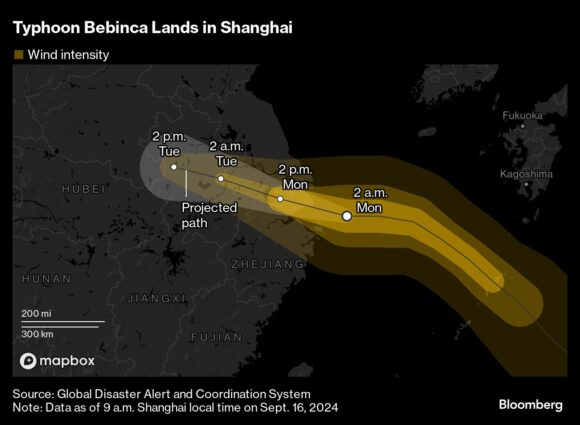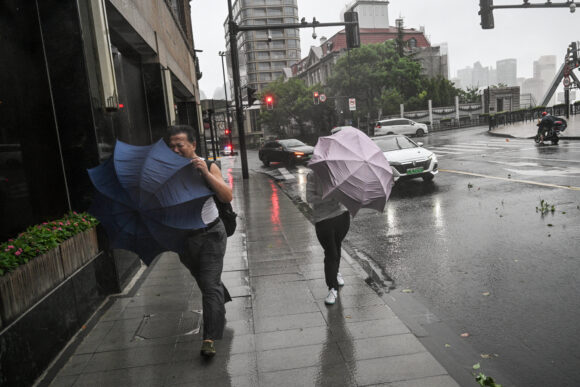The strongest typhoon in more than seven decades has struck China’s financial hub, leading to widespread flight cancellations and disrupting holidaymakers at the start of a days-long national festival.
Typhoon Bebinca — known as Beibijia in China — crossed the coast in the Yangtze River Delta region on Monday morning, and is expected to dump heavy rain across Jiangsu, Zhejiang and Anhui provinces as it tracks inland and weakens, according to reports from state media.
The storm is the second to hit China in a matter of weeks, after Super Typhoon Yagi struck Hainan island in the nation’s south, causing damage to wind farms and solar installations before flooding vast areas of northern Vietnam. Two more storms could also near the Chinese coast later in the week.
China Braces for Another Typhoon After Yagi Slammed South Coast
Bebinca had maximum sustained winds of 65 knots (120 kilometers) per hour before making landfall, according to the Joint Typhoon Warning Center. That made it equivalent to a Category 1 hurricane on the five-step Saffir-Simpson scale — the lowest intensity.
The typhoon was the strongest to hit Shanghai since 1949, according to a report from China Central Television. The city reported a small number of power outages and some flooding of farmland, CCTV said in a separate report.
Shanghai — a mega-city of 25 million people — initiated a top-level emergency response on Sunday, suspending railway services, closing ports, bridges and highways. Flights from both of the city’s airports were canceled overnight, but are resuming from 3 p.m. local time, according to a statement from the government. Some metro lines have also resumed operations.
China has canceled over 1,600 flights due to the typhoon, CCTV reported, citing the Civil Aviation Administration. The airport at Hangzhou, a city of about 13 million and home to Alibaba Group Holding Ltd., canceled more than one hundred flights, according to separate state media reports. The city is about 175 kilometers (109 miles) south west of Shanghai.
The typhoon will likely push a 1-to-2-meter storm surge into the Yangtze River, which will have its worst impact on the north side of Shanghai, Adam Douty, a meteorologist at AccuWeather Inc., said in an interview.

Bebinca led to the evacuation of hundreds of thousands of people in Shanghai and other coastal cities, and the travel plans of millions were disrupted at the start of the mid-autumn festival. Strong gale force winds up to 42 meters per second howled through Shanghai on Monday morning, state media said.
High-speed rail services have been halted across the Yangtze Delta. Zhoushan, home to some of China’s largest oil storage tanks and refineries, warned people to stay indoors as rain and strong winds began lashing the city on Sunday.
Two storms have formed that are forecast to track toward China by the end of this week — one is currently near the Philippines and the other near Guam.
Gener is forecast to make landfall in the Philippines over the next 24 hours before reforming and tracking toward southern China, crossing the coast on Friday, according to the Philippine Atmospheric, Geophysical and Astronomical Services Administration. Pulasan is expected to move toward eastern China and intensify into a severe tropical storm on Wednesday, Pagasa said.
Photograph: Pedestrians struggle with their umbrellas during Typhoon Bebinca in Shanghai on Sept. 16, 2024. Photo credit: Hector Retamal/AFP/Getty Images
Related:
Topics Catastrophe Natural Disasters
Was this article valuable?
Here are more articles you may enjoy.



 Wildfire Losses Drop Chubb Q1 Net Income 38%, While Tariffs Create ‘Confusion’
Wildfire Losses Drop Chubb Q1 Net Income 38%, While Tariffs Create ‘Confusion’  White House Seeks to Bring Financial Regulators Under Its Sway
White House Seeks to Bring Financial Regulators Under Its Sway  South Florida Insurance Broker Pleads Guilty to Fraud in $133M ACA Enrollment Scheme
South Florida Insurance Broker Pleads Guilty to Fraud in $133M ACA Enrollment Scheme  State Farm Wins Dismissal of Class Action Over Xactimate Software
State Farm Wins Dismissal of Class Action Over Xactimate Software 

